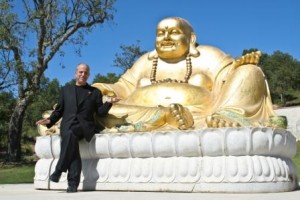
According to a recent article in The Art Newspaper, Portuguese entrepreneur and financier José Berardo has commissioned additions inspired by the Bamiyan Valley Buddhas for his Buddha Eden Garden, north of Lisbon.
Six thousand tons of stone sculptures carved by sculptors based in Shijiazhuang, China, have been commissioned for the park (that being the approximate weight of the Bamiyan Buddhas) and the creation of the garden itself was prompted by the destruction of the Buddhas in central Afghanistan in 2001. The garden contains a number of large-scale Asian sculptures scattered over 35 hectares at the Quinta dos Loridos, Bombarral, including terracotta warriors based on those that guarded the tomb of China’s first emperor, Qui Shi Huang.
Meanwhile, works by Fernando Botero and Tony Cragg, among others are expected for the garden`s new Modern and Contemporary section. These will join other sculptures purchased in past years, such as those from a 2007 deal with the Cass Sculpture Foundation, based in southeast England, which included a work by Lynn Chadwick.
José Berardo (commonly known as Joe Berardo) was born into a humble family on the island of Madeira. By his late teens he had migrated to South Africa, where he built businesses in retail as well as gold mining and refining. Returning to Portugal in the mid-1980s, he expanded his fortune with investments in wineries, the banking sector and the stock market. By the 2000s, Berardo had accumulated a fortune that landed him a spot on the Forbes World Billionaires list.
Berardo has garnered some less positive attention in his dealings within Portuguese business circles. In 2007 he failed in a friendly takeover bid of Benfica football club. He also spearheaded a complaint over the mishandling of funds by executives at Banco Comercial Português S.A., where he held a majority stake. More recently, he sold his stake in Portugal’s largest wine company, Sogrape (Mateus, Bodegas LAN and Sandeman) to the Guedes family after a six-year court battle.
But besides his business ventures, Berardo also set his sights on amassing a private art collection that includes a who’s who of Modern and Contemporary art. He also has a number of other collections, ranging from historical azulejos (Portuguese tiles), furniture, and decorative porcelain, to the more eclectic — chamber pots, for example.
One of the key characteristics of his collections lies not just in their breadth but that much of their content has been on public display at various locations. As quoted in a 2011 New York Times article, Berardo seemed keen in his role as art collector, noting that anyone “who has got power or a bit of money should contribute to the preservation of culture.” Furthermore, he explained that Portugal needed to attract more than sun-seeking beachgoers: “We need museums and the cultural side.”
Public spaces for tycoons’ art
He is part of a broader trend of private contemporary art collectors establishing public spaces to display their vast art collections. Several well-known examples of these kinds of arrangements exist in Europe. Bernard Arnault, head of luxury goods conglomerate LVMH, is currently building a Frank Gehry-designed museum in Paris for his collection (due to open late 2013). Plans are underway to develop New Holland Island in St. Petersburg, which is speculated to exhibit artworks from billionaire Roman Abramovich’s collection. In 2005, PPR’s François Pinault acquired Venice’s Palazzo Grassi to display his collection while other portions have been exhibited at Punta della Dogana. The Iberian Peninsula is also no stranger to this trend with perhaps its most famous example being Madrid’s Thyssen-Bornemisza Museum.
After years of discussions and threats to move the collection abroad, Berardo struck a deal with the Ministry of Culture in 2006 that allowed for a portion of his art collection to be housed as the Museu Colecção Berardo at a state-owned complex, Lisbon’s Belém Cultural Centre. The deal also included an equal contribution of funds towards new acquisitions, with an option for the government to purchase the collection within 10 years.
In December 2012, a Miami-based art gallery launched an exhibition called “Masterpieces from the Berardo Collection” coinciding with Art Basel Miami Beach art fair. The exhibition occurs amid speculation of a long-term agreement to display his extensive Art Deco collection with an unnamed cultural institution in that city.
Leave a Reply
You must be logged in to post a comment.